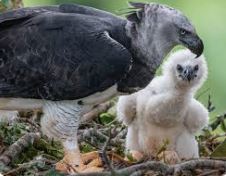The harpy eagle (Harpia harpyja) is a large neotropical species of eagle. It is also called the American harpy eagle to distinguish it from the Papuan eagle, which is sometimes known as the New Guinea harpy eagle or Papuan harpy eagle. It is the largest bird of prey throughout its range, and among the largest extant species of eagles in the world. It usually inhabits tropical lowland rainforests in the upper (emergent) canopy layer. Destruction of its natural habitat has caused it to vanish from many parts of its former range, and it is nearly extirpated from much of Central America. The genus Harpia, together with Harpyopsis, Macheiramphus and Morphnus, form the subfamily Harpiinae.
The harpy eagle was first described by Carl Linnaeus in his landmark 1758 10th edition of Systema Naturae as Vultur harpyja, after the mythological beast harpy. It is now the only species placed in the genus Harpia that was introduced in 1816 by the French ornithologist Louis Pierre Vieillot. The harpy eagle is most closely related to the crested eagle (Morphnus guianensis), the Papuan eagle (Harpyopsis novaeguineae) and the bat hawk (Macheiramphus alcinus), the four composing the subfamily Harpiinae within the large family Accipitridae. Previously thought to be closely related, the Philippine eagle has been shown by DNA analysis to belong elsewhere in the raptor family, as it is related to the Circaetinae.
The specific name harpyja and the word "harpy" in the common name both come from Ancient Greek harpyia (ἅρπυια). They refer to the harpies of Ancient Greek mythology. These were wind spirits who flew the dead to Hades or Tartarus, purported to have the lower body and talons of a raptor and the head of a woman, standing anywhere from the height of a tall child to as high as a grown man; some depictions have the creatures possessing an eagle-like body with the exposed breasts of an elderly female human, a giant wingspan and the head of a grotesque, sharp-toothed, mutant eagle—something more akin to a goblin with wings.

